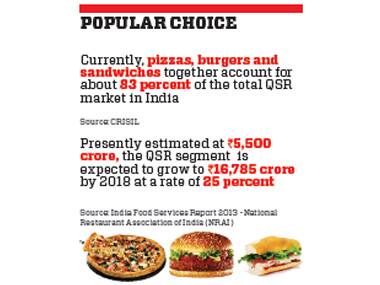Have you seen a dosa chef in action, laboriously spreading batter in concentric circles on a pan with the base of a ladle as he fries and flips this crepe-like staple South Indian dish one after the other? Amazingly, each one is perfectly round.
“It is difficult to make dosas. It is quite an art. That is why many restaurants have a dedicated chef to make dosas,” says Eshwar K Vikas, 22, an engineering student of SRM University in Chennai, batch of 2011.
The internet throws up an interesting statistic. Indians eat 1.2 billion dosas everyday and dosa is one of several desi food items that has percolated into the fast-growing quick service restaurant (QSR) segment, though it is still far behind the American fast food.
Research and analytics house CRISIL, in its report Organized Fast Food in the Fast Lane, says pizzas and burgers are more popular compared to Indian food in this segment because it is not easy to adapt the latter into an assembly line production model.
“We noticed that there is no automation or assembly set up in the Indian foods sector,” says Vikas, who, along with 22-year-old batchmate Sudeep Sabat, saw an opportunity and started developing an automated dosa making machine.
The raw cut
At this point, the duo just had a prototype of the intended machine - a rather large one with dimensions of one meter by one and a half meters and a height of one and a half meters which they set up outside few restaurants in Chennai to test its efficiency on the ground.“Space comes at a premium for restaurants.
A smaller machine was needed,” says Vikas. A year later, in early 2012, 22-year-old Sudarshan Lodha, a lawyer by profession, joined the duo to help with the legal and business aspect of things while they arduously fine-tuned the machine.
With funds totalling Rs 10 lakh for product development - from the team’s summer internship savings, a grant from the University, money borrowed from parents and some college level competitions - they set up a full-fledged venture, Mukunda Foods Pvt. Ltd, in May 2012.
What exists today is the ‘Dosa Matic’ that got its finishing touches with the Indian Angel Network (IAN) when it was inducted into its incubator program in May 2012. Incubation helped them network with players in the restaurant and hospitality sector and improve the prototype.
Hari Balasubramaniam of IAN, mentor and subsequent investor in the company says the boys’ core strength in engineering and incubation also helped hone a manufacturing mindset. “The
prototype was large and not the best, but the team had something to work with and improve at this stage.”
Flat, in under a minute
Dosa Matic is an automatic tabletop dosa making machine sized at 50 centimeters by 60 centimeters and one foot tall. Priced at Rs 60,000, its targets are QSR chains and food businesses.
“We are looking to develop a product at Rs 3000, for domestic use in households,” says Vikas, Co-founder, Mukunda Foods Pvt. Ltd. The Dosa Matic, he claims, makes 50 dosas per hour. Users can customize it in four areas-size, thickness, color, and oil content, all of which are controlled at the touch of a button. The machine works on electricity, holds five kilograms of dosa batter at a time and can operate for five hours non-stop, except when itneeds cleaning.
Mukunda raised an undisclosed amount of funding from IAN in August 2013 and with it, has now established a Research and Development (R&D) center and an assembly line set up to make the final product, both in Bengaluru.
“It is expensive to develop a product. Till we got funding, we did not have the bandwidth to manufacture a large number of machines,” Vikas admits. Dosa Matic has been in the marketfrom October this year and Mukunda has received 1,000 orders to date from restaurants, individual caterers and five-star hotels.
Its demo center in Bengaluru gives potential customers a hands-on feel. “We encourage people to bring their own batter so they can see that no separate batter is required to make dosas in this machine,” says Vikas.

An early buyer, Uma Shankar, who runs a tiffin delivery service, Sri Balaji Tiffins, bought Dosa Matic to reduce dependency on her chef. “The number of dosas I could make was restricted and not enough to supply to all the students to whom I deliver tiffins,” Shankar says.
Customers can get a return on investment in three months on an average, depending on the number of dosas sold and based on the market price of cooking gas.
Dosa Matic ensures savings of around 30 percent, Vikas claims.
A bigger meal
“There was a similar attempt by Dosa King over a decade ago that failed,” mentions Balasubramaniam who is confident that Dosa Matic has a large market today, not only domestically but also among Non-Resident Indians craving for food from the homeland.
“The plan now is to establish a strong supply chain and then expand to other related products, like ready-to-use chutneys and sambhar to go with dosas in the next two to three years,” says Balasubramaniam.
Samir Kuckreja, President of National Restaurant Association of India, feels that acceptance of products to automate Indian foods will be based on the end taste. “Most South Indian restaurants don’t use machinery because the taste of handmade food is best. What could workis automating some processes which don’t necessarily impact taste of the end product.” As an immediate plan of action, incorporating customer feedback is critical since it’s new in the market, Balasubramaniam believes.
On funding the next phase, Vikas says, “The money is sufficient for us to create a new product and take care of marketing. For the next 12 months at least we won’t need to raise funding.”
The boys definitely have a full plate on their hands.
This article first appeared in Entrepreneur India magazine.
)